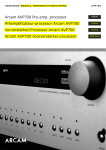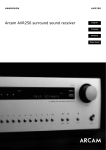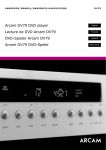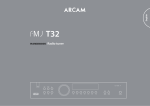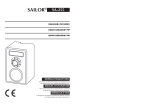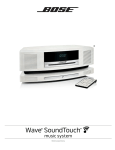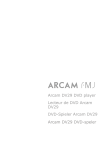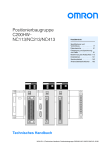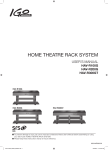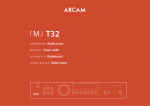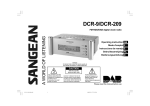Download Arcam DT91 Car Stereo System User Manual
Transcript
H A N DBOOK/MANUEL/HANDBUCH / H A N D L E I D I N G Arcam DT91 digital radio tuner DT91 English Tuner radio numérique DT91 Arcam Français Digitaler Radiotuner Arcam DT91 Deutsch Arcam DT91 digitale radio tuner Nederlands Safety guidelines CAUTION ATTENTION RISK OF ELECTRIC SHOCK DO NOT OPEN RISQUE DE CHOC ELECTRIQUE NE PAS OUVRIR CAUTION: To reduce the risk of electric shock, do not remove cover (or back). No user serviceable parts inside. Refer servicing to qualified service personnel. WARNING: To reduce the risk of fire or electric shock, do not expose this apparatus to rain or moisture. The lightning flash with an arrowhead symbol within an equilateral triangle, is intended to alert the user to the presence of uninsulated ‘dangerous voltage’ within the product’s enclosure that may be of sufficient magnitude to constitute a risk of electric shock to persons. The exclamation point within an equilateral triangle is intended to alert the user to the presence of important operating and maintenance (servicing) instructions in the literature accompanying the product. CAUTION: In Canada and the USA, to prevent electric shock, match the wide blade of the plug to the wide slot in the socket and insert the plug fully into the socket. Important safety instructions This product is designed and manufactured to meet strict quality and safety standards. However, you should be aware of the following installation and operation precautions: 1. Take heed of warnings and instructions You should read all the safety and operating instructions before operating this appliance. Retain this handbook for future reference and adhere to all warnings in the handbook or on the appliance. Power supply cords should be routed so that they are not likely to be walked on or pinched by items placed upon or against them, paying particular attention to cords and plugs, and the point where they exit from the appliance. 11. Grounding Ensure that the grounding means of the appliance is not defeated. 2. Water and moisture 12. Power lines The presence of electricity near water can be dangerous. Do not use the appliance near water – for example next to a bathtub, washbowl, kitchen sink, in a wet basement or near a swimming pool, etc. Locate any outdoor antenna/aerial away from power lines. 3. Object or liquid entry Take care that objects do not fall and liquids are not spilled into the enclosure through any openings. Liquid filled objects such as vases should not be placed on the equipment. 4. Ventilation Do not place the equipment on a bed, sofa, rug or similar soft surface, or in an enclosed bookcase or cabinet, since ventilation may be impeded. 5. Heat Locate the appliance away from naked flames or heat producing equipment such as radiators, stoves or other appliances (including other amplifiers) that produce heat. 6. Climate The appliance has been designed for use in moderate climates. 7. Racks and stands Only use a rack or stand that is recommended for use with audio equipment. If the equipment is on a portable rack it should be moved with great care, to avoid overturning the combination. 8. Cleaning Unplug the unit from the mains supply before cleaning. The case should normally only require a wipe with a soft, damp, lint-free cloth. Do not use paint thinners or other chemical solvents for cleaning. We do not advise the use of furniture cleaning sprays or polishes as they can cause indelible white marks if the unit is subsequently wiped with a damp cloth. 9. Power sources Only connect the appliance to a power supply of the type described in the operating instructions or as marked on the appliance. This is a class 1 appliance and must be earthed. DT91 E-2 10. Power-cord protection 13. Non-use periods If the unit has a stand-by function, a small amount of current will continue to flow into the equipment in this mode. Unplug the power cord of the appliance from the outlet if left unused for a long period of time. 14. Abnormal smell If an abnormal smell or smoke is detected from the appliance, turn the power off immediately and unplug the unit from the wall outlet. Contact your dealer immediately. 15. Servicing You should not attempt to service the appliance beyond that described in this handbook. All other servicing should be referred to qualified service personnel. 16. Damage requiring service The appliance should be serviced by qualified service personnel when: A. the power-supply cord or the plug has been damaged, or B. objects have fallen, or liquid has spilled into the appliance, or C. the appliance has been exposed to rain, or D. the appliance does not appear to operate normally or exhibits a marked change in performance, or E. the appliance has been dropped or the enclosure damaged. Safety compliance This product has been designed to meet the IEC 60065 international electrical safety standard. Using this handbook This handbook has been designed to give you all the information you need to install, connect, set-up and use the Arcam DiVA DT91. The remote control handset supplied with the equipment is also described. It may be that the DT91 has been installed and set-up as part of your Hi-Fi installation by a qualified Arcam dealer. In this case, you may wish to skip the sections of this handbook dealing with installation and setting up the unit, and move directly to the sections dealing with using the player. Use the contents list to guide you to these sections. Safety Safety guidelines are set out on page 2 of this handbook. Many of these items are common sense precautions, but for your own safety, and to ensure that you do not damage the unit, we recommend that you read them. This is a class 1 product and requires an earth connection. Safety guidelines ....................................... E-2 Important safety instructions ................. E-2 Safety compliance ................................ E-2 Using this handbook.............................. E-3 Positioning the unit ............................... E-4 Connecting up ...................................... E-4 Installation ............................................... E-4 Setting up the aerial ............................. E-5 Using your tuner ....................................... E-6 Front-panel controls .............................. E-6 Searching for radio stations: DAB ........... E-6 Search for radio stations: FM.................. E-7 Programming a preset radio station......... E-7 Changing the display mode .................... E-7 The CR-389D remote control ....................... E-8 Technical specifications............................... E-9 Remote-control codes .............................. E-10 Guarantee .............................................. E-10 On line registration ............................. E-10 Appendix: Serial programming interface ..... E-11 Introduction....................................... E-11 Command and response formats........... E-11 Command Specifications...................... E-12 DT91 E-3 E nglish Contents Installation Positioning the unit n n n n n Place the DT91 on a level, firm, surface, avoiding direct sunlight and sources of heat or damp. Avoid placing the DT91 on top of a power amplifier or other source of heat. The DT91 may run warm during normal operation, so avoid placing the DT91 in an enclosed space such as a bookcase or closed cabinet unless there is good ventilation. Make sure the remote-control receiver in the centre of the front panel display is unobstructed, otherwise remote-control will be unreliable. If line-of-sight is impractical, a remote-control repeater can be used with the rear panel connector. (see below). Avoid placing a record deck on top of this unit. Record decks are very sensitive to the noise generated by mains power supplies which will be heard as ‘hum’ if the record deck is too close. Connecting up Digital outputs The DT91 is fitted with both optical and co-axial digital audio outputs; the two carry the same information at all times. If you wish, these can be connected to an external DAC or your AV receiver, which may enhance the final audio quality. Alternatively, they can also be used to connect this tuner to a digital recording device (such as a CD-R or Minidisc recorder) for direct recording. RS232 interface Supply voltage Move the slider to 115V or 230V, depending on the mains supply voltage in your area. The serial interface is available for controlling the DT91 from a computer or other controller. The remote control protocol is described in the Appendix to this handbook. When listening to a DAB radio station, these outputs carry audio with a sample rate of 48kHz; when an FM station is being received, the sample rate is 32kHz. AUDIO OUTPUTS DIGITAL OUT AERIAL INPUT 230V 115V SUPPLY VOLTAGE POWER INLET PROGRAM RS232 REMOTE IN OPTICAL COAX L R 1 2 115/230V Mains lead Remote control in Aerial input socket Analogue audio outputs The appliance is normally supplied with a moulded mains plug already fitted to the lead. If for any reason the plug needs to be removed, it must be disposed of immediately and securely, as it is a potential shock hazard when inserted into the mains socket. If you are using this tuner with an amplifier that also features a remote bus (such as the Arcam DiVA AVR300) you can connect the REMOTE OUT of the amplifier to the REMOTE IN of the tuner using a 3.5mm jack lead. The coaxial cable from the aerial should be fitted with a 50Ω F-type (screw) connector. Connect this to the aerial socket on the back of this tuner, pushing the pin into the centre of the socket, then screwing on the cover to lock in place. Two pairs of stereo analogue outputs are provided by the DT91, both of which provide the same signals. Connect one pair of these outputs to your amplifier using a suitable stereo phono cable. The second output pair may be connected to some other audio device, as desired, such as a cassette deck. Check that the plug supplied with the unit fits your supply and that your mains supply voltage agrees with the voltage setting (115V or 230V) indicated on the rear panel of the unit. If your mains supply voltage or mains plug is different, or you require a new lead, please consult your Arcam dealer. PLUGGING-IN Push the plug (IEC line socket) of the power cable supplied with the unit into the socket (POWER INLET) in the back of the unit. Make sure it is pushed in firmly. This allows the tuner to be positioned out of sight while still offering remote control, since commands are passed through the amplifier. It can also be used to route control signals for multiroom use. The remote control input requires a mono 3.5mm jack, with the tip active and the sleeve grounded. The remote control signals must be in modulated RC5 format, with a voltage level of between 5V and 12V. DT91 E-4 Take care not to overtighten the F-connector (finger tighten only – do not use tools as this may damage the circuit board behind the connector). See ‘Setting up the aerial’ for further information on the aerial type to use. Note that interconnecting cables are not supplied with this tuner. We recommend the use of high-quality screened cables, since inferior-quality cables will degrade the overall quality of your system. Use only cables that are designed for an audio application as other cables will have different impedance characteristics that will degrade the performance of your system (for example, do not use cabling intended for video use to carry audio signals). All cables should be kept as short as is practically possible. It is good practice when connecting your equipment to make sure that the mains power-supply cabling is kept as far away as possible from your audio cables. This avoids unwanted noise in the audio signals. Setting up the aerial If the transmission signal is strong in your area then the supplied indoor aerial may be sufficient (it should be hung on a wall with both wires fully stretched out vertically). An external aerial is recommended in order to receive the highest number of services. VH F/F DA M B E nglish Your new Arcam tuner is capable of superb reception, but only if it is receiving a good quality transmission signal. DAB transmissions can be in either ‘Band III’ or the ‘L-band’ (or both). To determine the transmission frequency in your area, contact your dealer, or refer to www.WorldDAB.org. In Band III transmission areas, use a multi-element Yagi aerial if you are a long way from a transmitter, or use an omnidirectional or folded dipole aerial if you are close to more than one transmitter (in the U.K., a Band III region, this should be mounted with the elements vertically, as the transmissions are vertically polarised). If the DAB services in your area are transmitted on L-band then consult your dealer for advice on the best aerial to use. You may have noticed that, although the DT91 supports both DAB and FM radio, there is only one aerial connector on the rear panel. If you wish to feed signals from both aerial types into the unit, a low-loss signal combiner must be used, as shown in the diagram. Otherwise, choose the aerial type for the medium you use most often. Whether you decide to install an external aerial, or opt to use the supplied ribbon cable, it should be connected to the F-type (screw) connector labelled AERIAL INPUT on the rear of the unit. Aerial combiner The type of aerial you should use depends on your listening preferences and the local conditions. If you listen exclusively to FM transmissions, for example, and the FM signal strength is strong in your area, then a simple omni-directional aerial mounted in your loft or on your roof may be sufficient. Listening to DAB in a weak signal area will require a high-gain, roof-mounted aerial. For the best reception of both DAB and FM signals, an aerial combiner box may be required (as shown in the diagram above). This combines the signals received by two aerials (one for DAB, the other for FM), into one cable that then connects to the DT91. If an aerial combiner is not used, the single aerial chosen for both DAB and FM reception may not give optimum performance in some regions. For the best advice, we recommend that you contact your local Arcam dealer or an aerial installation expert. DT91 E-5 Using your tuner Front-panel controls MENU Preset station selection Opens the configuration menu for the DT91. See the sections ‘Searching for radio stations: DAB’ and “Searching for radio stations: FM”, for further information. These buttons allow quick selection of up to 16 preset radio stations. For a preset between 1 and 8, press and release the appropriate button – for a preset between 9 and 16, press and hold the appropriate button. SELECT POWER The SELECT button confirms an action within the configuration menu. This switches the tuner on and off. When the tuner is switched on the status LED is green. DT91 FM + DIGITAL RADIO TUNER 1–9 2–10 3–11 4–12 5–13 6–14 7–15 8–16 SEARCH STORE 1–8 MENU SELECT STORE 9–16 DISPLAY MODE DAB/FM POWER SEARCH STORE 1–8, STORE 9–16 Control knob DAB/FM In DAB mode, pressing SEARCH scans for new DAB radio stations. See ‘Searching for radio stations: DAB’, for further information. These buttons are used when specifying a preset location (1–8 or 9–16) to store a radio station. See ‘Programming a preset radio station’, for further information. In DAB mode, rotate the control knob to cycle through stations until the one you wish to listen to is displayed. In FM mode, rotating the control knob changes the tuning frequency. Switches between DAB and FM mode. DISPLAY MODE Press this button to change the type of information shown on the display (such as scrolling text or signal strength). Searching for radio stations: DAB When using the DAB tuner section for the first time, you should perform a search to find the available services in your area. You may also wish to repeat the search periodically to discover if any new ensembles (i.e. groups of services) have gone on air, or if you move the tuner to a different area. To perform a search Ensure that the DT91 is in DAB mode (by pressing the DAB/FM button until ‘DAB’ is shown on the display), then press SEARCH or MENU; the display shows ‘DAB Setup: Press SELECT to scan’. Press SELECT to start searching for new stations. The current search frequency is shown on the display as the search progresses. A complete search may take three minutes or so to complete. You cannot cancel a search once started. If no service is found after the search, then either your aerial is inadequate or you may be outside of the area covered by DAB broadcasts. Please contact your Arcam dealer for further information or advice. Selecting a service Turn the rotary controller (or press 4 or 3 on the remote control) to work through the available stations and to choose the one you wish to listen to. The service displayed will be selected automatically after a delay of about two seconds. Deleting services Under normal circumstances, you should not need to delete services from the DT91. If you move to a different region, however, or if a station ceases transmission, stations may be shown as available that can no longer be received. Individual stations cannot be deleted. To remove stations from the selection list that can no longer be received, first press the MENU button; the display shows ‘DAB Setup: Press SELECT to scan’. Turn the control knob until the display shows ‘DAB Setup: Press SELECT to erase’, then press SELECT. All services are deleted. DT91 E-6 A delete operation should always be followed by a search for available stations (as described previously) otherwise no DAB radio stations will be available for selection. Search for radio stations: FM To perform a search Ensure that the DT91 is in FM mode (by pressing the DAB/FM button until ‘FM’ is shown on the display). E nglish There are two methods to search for stations in FM mode. If you know the broadcast frequency of the station you want, turn the control knob on the front-panel until the desired frequency is displayed. You should then hear the required radio station. An alternative search method is to press and hold the 4 or 3 keys on the remote control. After a delay of about one second, the DT91 begins scanning for the next available station. On finding a station with a strong enough signal, the DT91 stops scanning, plays the station and displays the station details. If no stations can be received, then your aerial is not providing an adequate signal. Please contact your Arcam dealer for further information or advice. Switching to mono In some weak signal areas it can be beneficial to force the FM tuner to mono output, as mono requires a much lower signal strength to produce acceptable results. Press MENU, then turn the control knob until ‘Mono’ is displayed. If the signal strength in your area is good, leave this set to ‘Stereo’. Programming a preset radio station Preset stations are available for both DAB and FM. Up to 16 stations can be stored as presets. First select the radio station you wish to assign to a preset. Press STORE 1–8 or STORE 9–16, then press the appropriate preset button to store the service. Selecting a preset To select presets 1 to 8, press and release the corresponding button. To select presets 9 to 16, press and hold the corresponding button for two seconds. Changing the display mode The bottom line of the display can be set to different modes: programme type, transmission frequency, dynamic label (scrolling text), data rate (showing service data rate and stereo/mono mode) and signalquality (a bar graph). Press DISPLAY MODE on the front panel or MODE on the remote control to cycle through these display options. Note that the display modes for DAB and FM are set independently. Programme type The ‘programme type’ label is a short description of the type of programme being transmitted, and (if selected) is displayed below the station name. Transmission frequency (FM only) The transmission frequency setting shows the station name (if available), together with the frequency the station is being transmitted on. This can be useful, in areas where the same station is transmitted on different frequencies, in ensuring that the correct transmission of the station is selected. Dynamic label (DAB) / RDS (FM) This is a 128 character block of scrolling text used by most broadcasters to display programme information (such as song titles, useful phone numbers and website addresses). Data rate (DAB only) The data rate setting allows the data rate of the station, together with the MPEG mode, to be seen. The data rate is given in kbits/second, with a higher data rate indicating better audio quality. The maximum data rate supported by the DT91 is 224kbps, but most radio stations are broadcast at 128kbps, or less. The MPEG mode of the station indicates whether the station is broadcast in stereo or mono. Signal quality The signal quality meter is a simple bargraph that gives a quick visual guide to reception quality. For DAB transmissions, it is an inverse measure of the Viterbi error rate, with zero errors at full scale (all segments are lit) and 500 errors/second (with all segments off). For FM transmissions, the bar graph shows a simple analogue measurement of signal strength. Secondary services (DAB only) Primary services can have one or more secondary services attached to them. These tend to be temporary; sporting events such as football matches, for example, may be broadcast as secondary services. Services that have secondary services attached to them are indicated by a ‘>’ symbol. Turning the rotary selector clockwise will then reveal these services. The secondary services themselves are indicated by a ‘<’ symbol. You need to select a main service in order to see if there are secondary services attached. Note that only primary services can be attached to a preset. DT91 E-7 The CR-389D remote control FM/DAB MENU Use this button to switch between FM and DAB mode. The LED above the FM/DAB button is lit briefly when the button is pressed to show which mode is selected. This button has the same function as the MENU button on the front panel of the tuner. DISP TUNER FM This button toggles the tuner’s display between on and off. DAB Preset memory buttons These buttons allow access to individual preset stations. To select a preset press the corresponding button. For presets 9 to 16, press and hold the corresponding preset button for two seconds. MODE This button has the same function as DISPLAY MODE on the front panel. FM DAB MENU DISP 1-9 2-10 3-11 4-12 5-13 6-14 7-15 8-16 MODE TUNE buttons BAND These buttons enable you to scroll through the available stations. For more information on tuning radio stations in, see the sections ‘Searching for radio stations: DAB’ and ‘Searching for radio stations: FM’ on page 6 and 7. SP1 BAND SP2 ENTER DISP This button has the same function as SELECT on the front panel. SEL Amplifier controls These buttons offer basic control over Arcam amplifiers. PHONO AUX CD TUNER AV DVD VCR TAPE AMPLIFIER PROG RPT CD player controls DISP These buttons offer basic control over Arcam CD players. CD CR-389 Note: Remember to install the two AAA batteries supplied before trying to use your remote control. DT91 E-8 Do not place anything in front of the tuner (where the IR receiver is located), or the remote control may not work. Technical specifications Digital audio output SPDIF co-axial to gold-plated phono sockets E nglish Format SPDIF optical to TOSLINK Sample rate 48kHz (DAB mode) 32kHz (FM mode) Output impedance (co-axial) 75Ω unbalanced Analogue audio output Connectors Two pairs of stereo outputs to gold-plated phono sockets Output level 2.4Vrms at 0dB FS (DAB mode) 0.9Vrms at full modulation (FM mode) Output impedance <100Ω Minimum load 600Ω Frequency response (±0.5dB) 20Hz–20kHz RF performance (DAB mode) Tuning range 174–240MHz (Band III) 1452–1492MHz (L band) Sensitivity (VHF measurement to EN50248) better than –91dBm, typically –97dBm Audio data rate (maximum) 224kbits/s at MPEG protection level 3 RF performance (FM mode) Tuning range 87–108MHz Sensitivity (IHF) 3µV typical Signal to noise ratio 65dB at full modulation, 1kHz THD+n 0.1% at full modulation, 1kHz Aerial Connector F type Impedance 50Ω Remote control interface Remote bus input 36kHz modulated RC5 on 3.5mm mono jack socket Serial port RS232 to 9-way male D connector, DTE pin out. Remote control codes given in table on following page. General Supply voltage 115 or 230Vac, set by rear panel voltage selector switch Power consumption <20W Size W435 x D320 x H83mm Weight 3.6kg (net), 6kg (packed) Supplied accessories CR-389D remote control two x AAA batteries Mains lead Indoor ribbon aerial E&OE Note: All specification values are typical unless otherwise stated. Continual improvement policy Arcam has a policy of continual improvement for its products. This means that designs and specifications are subject to change without notice. DT91 E-9 Remote-control codes The following table gives the IR commands accepted by the DT91. The system code for the DT91 is 17 (in common with other Arcam tuners). Power commands Command Decimal Code Power on 123 Power off 124 Tuner control commands Command Decimal Code Select DAB 126 Select FM 127 MENU 61 or 125 DISP 18 or 71 1–9 1 or 91 2–10 2 or 92 3–11 3 or 93 4–12 4 or 94 5–13 5 or 95 6–14 6 or 96 7–15 7 or 97 8–16 8 or 98 MODE 37 or 121 < 33 or 78 > 32 or 77 BAND 50 or 87 Guarantee Worldwide Guarantee This entitles you to have the unit repaired free of charge, during the first two years after purchase, at any authorised Arcam distributor provided that it was originally purchased from an authorised Arcam dealer or distributor. The manufacturer can take no responsibility for defects arising from accident, misuse, abuse, wear and tear, neglect or through unauthorised adjustment and/or repair, neither can they accept responsibility for damage or loss occurring during transit to or from the person claiming under the guarantee. The warranty covers: Parts and labour costs for two years from the purchase date. After two years you must pay for both parts and labour costs. The warranty does not cover transportation costs at any time. Claims under guarantee This equipment should be packed in the original packing and returned to the dealer from whom it was purchased, or failing this, directly to the Arcam distributor in the country of residence. It should be sent carriage prepaid by a reputable carrier – not by post. No responsibility can be accepted for the unit whilst in transit to the dealer or distributor and customers are therefore advised to insure the unit against loss or damage whilst in transit. For further details contact Arcam at: Arcam Customer Support Department, Pembroke Avenue, Waterbeach, CAMBRIDGE, CB5 9QR, England. Problems? If your Arcam dealer is unable to answer any query regarding this or any other Arcam product please contact Arcam Customer Support at the above address and we will do our best to help you. On line registration You can register your Arcam product on line at: www.arcam.co.uk DT91 E-10 Appendix: Serial programming interface E nglish Introduction This section of the document describes the remote control protocol for controlling the DT91 via the RS232 interface. Conventions n The remote controller is referred to as the ‘RC’. n All values in this section are hexadecimal values, unless otherwise specified. Data transfer format n Transfer rate: 19,200bps. n 1 start bit, 8 data bits, 1 stop bit, no parity, no flow control. Command and response formats Communication between the RC and the DT91 takes the form of sequences of bytes, with all commands and responses having the same basic format. Communication between the two is full duplex. The DT91 shall always respond to a received command. Each transmission by the RC shall be at least five bytes long in the following format: <STR> <CC> <DL> <Data> <ETR> n STR (Start transmission): 0x21 n CC (Command code): the code for the command n DL (Data length): the number of data items following this item, excluding the ETR n Data: the parameters for the command n ETR (End transmission): 0xD Each response by the DT91 shall be at least six bytes long in the following format: <STR> <RC> <AC> <DL> <Data> <ETR> n STR (Start transmission): 0x21 n RC (Reply code): = command code n AC (Answer code): answer code (see below) n DL (Data length): the number of data items following this item, excluding the ETR n Data: the information associated with this response n ETR (End transmission): 0xD Note that the DT91 shall transmit messages whenever its status changes. State changes as a result of other inputs It is possible that the state of the DT91 may be changed as a result of user input via the front panel buttons or via the IR remote control. Changes resulting from these inputs shall be relayed to the RC (using the appropriate message type) as they occur. For example, if the user changed the front panel display brightness using the DISP button on the remote control, a display message (defined below) would be sent to the RC. A similar action would be taken for all other state changes. Answer codes The following answer codes are defined: n Command OK 0x1: The command has been accepted and processed completely. n Command Failed 0x0: The command has failed for some reason. DT91 E-11 Command Specifications / Spécifications des commandes / Befehlsspezifikationen / Opdrachtspecificaties Power / Alimentation / Betrieb / Stroom �� � � �� Change the stand-by state of the DT91. Permet de modifier l'état de veille du DT91. Ändern des Stand-by-Zustands des DT91. De Stand-by status van de DT91 wijzigen. COMMAND: Byte: Description: CC 0x00 (Command code) DL 0x01 (Data length) D1 0x00 – Enter stand-by state 0x01 – Power-on 0xF2 – Toggle power state 0xF3 – Request power state Example / Exemple / Beispiel / Voorbeeld �� Command/response sequence to bring the DT91 out of standby: Séquence de commande/réponse pour désactiver le mode veille du DT91 : � Befehls-/Rückmeldesequenz zur Aktivierung des im Stand-by-Modus befindlichen DT91: � �� Opdracht- en responsreeks om de DT91 uit stand-by te halen: RESPONSE: Byte: Description: RC 0x00 (Reply Code) AC Answer code DL 0x01 (Data length) D1 Response: 0x00 – The DT91 is in stand-by state 0x01 – The DT91 is powered on COMMAND: 0x21 0x00 0x01 0x01 0x0D RESPONSE: 0x21 0x00 0x01 0x01 0x01 0x0D Source selection / Sélection de la source / Quellenauswahl / Bronkeuze �� Switch between DAB and FM. � Bascule entre les modes RAN et FM. � Wechsel zwischen DAB und FM �� Schakel om naar DAB en FM. COMMAND: Byte: Description: CC 0x01 (Command code) DL 0x01 (Data length) D1 0x01 – FM 0x02 – DAB 0xF3 – Request current source Example / Exemple / Beispiel / Voorbeeld �� � � �� Command/response sequence to switch to FM: Séquence de commande/réponse pour basculer en mode FM : RESPONSE: Befehls-/Rückmeldesequenz zum Umschalten auf FM: Byte: Description: Opdracht- en responsreeks om naar FM over te schakelen: RC 0x01 (Reply Code) AC Answer code DL 0x01 (Data length) D1 Response: Source values as given above. COMMAND: 0x21 0x01 0x01 0x01 0x0D RESPONSE: 0x21 0x01 0x01 0x01 0x01 0x0D Display brightness / Luminosité de l'affichage / Helligkeit des Displays / Helderheid van de display �� � � �� Byte: Description: Définit la luminosité de l’affichage. CC 0x0A (Command code) Einstellen der Helligkeit des Displays. DL 0x01 (Data length) Instellen van de display-helderheid. D1 0xF0 – Increase the display brightness 0xF1 – Decrease the display brightness 0xF3 – Request current display brightness Example / Exemple / Beispiel / Voorbeeld RESPONSE: Command/response sequence to dim the display one level, where the result is that the display brightness is at level 1: Byte: Description: � Séquence de commande/réponse pour atténuer la luminosité de l’affichage d’un cran, à savoir la régler au niveau 1 : RC 0x0A (Reply Code) AC Answer code DL 0x01 (Data length) D1 Response: The new brightness level, 0x00 (off) - 0x02 (full brightness). �� Befehls-/Rückmeldesequenz zum Dimmen des Displays um eine Stufe. Die Helligkeit des Displays ist anschließend auf Stufe 1: � Opdracht- en responsreeks om het display één niveau te dimmen met als resultaat dat de display-helderheid zich nu op niveau 1 weergeeft: �� COMMAND: 0x21 0x0A 0x01 0xF1 0x0D RESPONSE: 0x21 0x0A 0x01 0x01 0x01 0x0D DT91 E-12 COMMAND: Set the display brightness. Set the display information type. COMMAND: � Définit l’affichage du type d’informations. Byte: Description: � Einstellen des Display-Informationstypus. CC 0x0C (Command code) �� Instellen van het display informatie type. DL 0x01 (Data length) D1 If the current source is FM: 0x00 – Set the display to show 0x01 – Set the display to show 0x02 – Set the display to show 0x03 – Set the display to show frequency sig. strength RDS info. prog. type If the current source is DAB: 0x00 – Set the display to show 0x01 – Set the display to show 0x02 – Set the display to show 0x03 – Set the display to show data rate sig. strength DLS info. prog. type �� Example / Exemple / Beispiel / Voorbeeld �� Command/response sequence to set the display text to show the programme type: � Séquence de commande/réponse permettent de régler l'affichage du texte pour afficher le type de programme : Befehls-/Rückmeldesequenz zum Einstellen des Display-Texts für die Anzeige des Programmtypus: � �� Opdracht- en responsreeks zodat de display tekst het programmatype weergeeft: COMMAND: 0x21 0x0C 0x01 0x03 0x0D RESPONSE: 0x21 0x0C 0x01 0x01 0x03 0x0D RESPONSE: Byte: Description: RC 0x0C (Reply Code) AC Answer code DL 0x01 (Data length) D1 Response: The new display setting. Preset selection / Préréglage de station / Preset-Auswahl / Selecteren van een voorinstelling �� Select a preset radio station. � Mémorise une station radio préréglée. � �� Description: Auswählen eines voreingestellten Radiosenders. CC 0x13 (Command code) Selecteer een vooringestelde zender. DL 0x01 (Data length) D1 0x1 - 0x10 – The selected preset. Example / Exemple / Beispiel / Voorbeeld �� Command/response sequence to select preset 12: Séquence de commande/réponse pour sélectionner la station préréglée 12 : � � �� COMMAND: Byte: Befehls-/Rückmeldesequenz zur Auswahl der Voreinstellung 12: Opdracht- en responsreeks om voorinstelling 12 te selecteren: RESPONSE: Byte: Description: RC 0x13 (Reply Code) AC Answer code DL 0x1 (Data length) Dn Response: The selected preset. COMMAND: 0x21 0x13 0x01 0x0C 0x0D RESPONSE: 0x21 0x13 0x01 0x0C 0x0D Station selection / Sélection d’une station RAN / DAB-Senderauswahl / Selecteren van een DAB zender Increment/decrement the DAB station selection. COMMAND: � Incrémente/décrémente la présélection de station RAN. Byte: Description: � Erhöhen/Verringern der DAB-Senderauswahl. CC 0xDE (Command code) �� Seleceteren van volgende/vorige DAB zender. DL 0x01 (Data length) D1 DAB only: 0xF0 – Select the next DAB station 0xF1 – Select the previous DAB station �� Example / Exemple / Beispiel / Voorbeeld �� Command/response sequence to increment the DAB station selection, where the new station is called “DAB STATION 2”: � Séquence de commande/réponse pour incrémenter la sélection de station RAN, la nouvelle station s’appelant alors « DAB STATION 2 » : DAB or FM: 0xF3 – Request the current station name RESPONSE: Befehls-/Rückmeldesequenz zur Erhöhung der DAB-Senderauswahl. Der neue Sender heißt „DAB STATION 2”: Byte: Description: RC 0xDE (Reply Code) Opdracht- en responsreeks voor het selecteren van de volgende DAB zender, waarbij de nieuwe zender ‘DAB STATION 2’ wordt benaamd: AC Answer code DL (Data length) Dn Response: The service label of the radio station, in ASCII characters � �� COMMAND: 0x21 0xDE 0x01 0xF0 0x0D RESPONSE: 0x21 0xDE 0x01 0x0D 0x44 0x41 0x42 0x20 0x53 0x54 0x41 0x54 0x49 0x4F 0x4E 0x20 0x32 0x0D DT91 E-13 E nglish Display information type / Affichage du type d’informations / Display-Informationstypus / Display informatie type Radio station information / Informations sur la station radio / Radiosenderinformationen / Zenderinformatie �� Request information on the current radio station. � Demande des informations sur la station radio actuelle. � Abfragen von Informationen zum aktuellen Radiosender. �� Vraag naar informatie over de huidige zender. Example / Exemple / Beispiel / Voorbeeld COMMAND: Byte: Description: CC 0xDF (Command code) DL 0x02 (Data length) D1 0xF3 – Request station information D2 0x00 – only) 0x01 – 0x02 – 0x04 – �� Command/response sequence to request the station frequency, where the source is FM and the frequency is 105.2MHz: � Séquence de commande/réponse pour demander la fréquence de la station, la source étant FM et la fréquence 105,2 MHz : Request the station frequency (FM Request the station signal strength Request the station MPEG mode Request the station data rate RESPONSE: Befehls-/Rückmeldesequenz zum Abfragen der Senderfrequenz. Die Quelle ist FM (analog) und die Frequenz 105,2 MHz: Byte: Description: RC 0xDF (Reply Code) Opdracht- en responsreeks voor het vragen naar de zendfrequentie, met als bron FM en de frequentie 105.2Mhz: AC Answer code DL 0x03 (Data length) D1 0x00 0x01 0x02 0x03 D2 Response to the FM frequency request: MHz of current frequency � �� COMMAND: 0x21 0xDF 0x02 0xF3 0x00 0x0D RESPONSE: 0x21 0xDF 0x01 0x03 0x00 0x69 0x14 0x0D Example / Exemple / Beispiel / Voorbeeld Message Message Message Message contains contains contains contains station freq. signal strength MPEG mode data rate Response to the DAB MPEG mode request: 0x00 – Stereo 0x01 – Joint stereo 0x02 – Dual mono 0x03 – Mono �� Command/response sequence to request the signal strength, where the current signal strength is 10: � Séquence de commande/réponse pour demander la puissance du signal, la puissance du signal actuelle étant de 10 : Response to the DAB data rate request: 0x00 - 0xE0 (0 - 224kb/s) – data rate � Befehls-/Rückmeldesequenz zum Abfragen der Signalstärke. Die aktuelle Signalstärke ist 10: Opdracht- en responsreeks om de signaalsterkte na te vragen, waarbij de signaalsterkte 10 is: – – – – Response to the signal strength request: 0x00 - 0x10 – signal strength �� D3 COMMAND: 0x21 0xDF 0x02 0xF3 0x01 0x0D Response to the FM frequency request: kHz (*10) of current frequency Response to the DAB MPEG mode request: 0x00 RESPONSE: 0x21 0xDF 0x01 0x02 0x0A 0x00 0x0D Response to the DAB data rate request: 0x00 Response to the signal strength request: 0x00 FM frequency selection / Sélection de la fréquence FM / FM-Frequenzauswahl / Selecteren van FM-frequentie Byte: Description: � Incrémente/décrémente la sélection de la fréquence FM. CC 0xE4 (Command code) � Erhöhen/Verringern der FM-Frequenzauswahl DL 0x01 (Data length) Selecteren van hogere/lagere FM-frequentie. D1 0xF0 – Increment the tuned frequency 0xF1 – Decrement the tuned frequency 0xF3 – Request the current tuned frequency �� Example / Exemple / Beispiel / Voorbeeld Command/response sequence to decrement the station frequency, where the new frequency is 97.9MHz: �� RESPONSE: Byte: Description: Séquence de commande/réponse pour décrémenter la fréquence de la station, la nouvelle fréquence étant 97,9 MHz : RC 0xE4 (Reply Code) AC Answer code Befehls-/Rückmeldesequenz zum Verringern der Senderfrequenz. Die neue Frequenz ist 97,9 MHz: DL 0x02 (Data length) D1 MHz of current frequency Opdracht- en responsreeks om een lagere zenderfrequentie te selecteren, met als nieuwe frequentie 97.9Mhz: D2 kHz (*10) of current frequency � � �� COMMAND: 0x21 0xE4 0x01 0xF1 0x00 0x0D RESPONSE: 0x21 0xE4 0x01 0x02 0x61 0x5A 0x0D DT91 E-14 COMMAND: Increment/decrement the FM frequency selection. �� Radio programme type / Type de programme radio / Erhöhen/Verringern der FM-Frequenzauswahl / Radioprogramma type Request information on the current station programme type. � Demande des informations sur le type de programme actuellement émis. � Abfragen von Informationen zum aktuellen Senderprogrammtypus. �� Vragen naar informatie over het programmatype van de huidige zender. Examples / Exemple / Beispiel / Voorbeeld �� Command/response sequence to request the programme type, where the programme type is “POP MUSIC”: COMMAND: Byte: Description: CC 0xE6 (Command code) DL 0x01 (Data length) D1 0xF3 – Request programme type RESPONSE: Byte: Description: Séquence de commande/réponse pour demander le type de programme, le type de programme étant « POP MUSIC » : RC 0xE6 (Reply Code) AC Answer code Befehls-/Rückmeldesequenz zum Abfragen des Programmtypus; der Programmtypus ist „POP MUSIC”: DL (Data length) Dn Response: The programme type of the selected station, in ASCII characters � � E nglish �� Opdracht- en responsreeks om te vragen naar het programmatype, waarbij het programmatype “POP MUSIC” is: �� COMMAND: 0x21 0xE6 0x01 0xF3 0x0D RESPONSE: 0x21 0xE6 0x01 0x09 0x50 0x4F 0x50 0x20 0x4D 0x55 0x53 0x49 0x43 0x0D Request RDS/DLS information / Demande d’informations RDS/DLS / Abfragen von RDS/DLS-Informationen / Vragen naar RDS/DLS informatie �� Request RDS/DLS (FM/DAB) information from the current radio station. COMMAND: Demande des informations RDS/DLS (FM/RAN) sur la station radio actuelle. Byte: Description: CC 0xE7 (Command code) Abfragen von RDS/DLS-Informationen (FM/DAB) vom aktuellen Radiosender. DL 0x01 (Data length) D1 0xF3 – Request RDS/DLS information � � �� Vraag naar RDS/DLS (FM/DAB) informatie van de huidige zender. Examples / Exemple / Beispiel / Voorbeeld Command/response sequence to request the RDS/DLS information, where the information is “Playing your favourite music”: �� Séquence de commande/réponse pour demander les informations RDS/ DLS, les informations étant « Playing your favourite music » (Ecouter votre musique favorite) : � RESPONSE: Byte: Description: RC 0xE7 (Reply Code) AC Answer code DL (Data length) Dn Response: The RDS/DLS information of the selected station, in ASCII characters. Up to 128 characters may be returned. � Befehls-/Rückmeldesequenz zum Abfragen der RDS/DLS-Informationen; es wird „Playing your favourite music” angezeigt: �� Opdracht- en responsreeks om naar de RDS/DLS informatie te vragen, met als informatie “Playing your favourite music”: COMMAND: 0x21 0xE7 0x01 0xF3 0x0D RESPONSE: 0x21 0xE7 0x01 0x1C 0x50 0x6c 0x61 0x79 0x69 0x6E 0x67 0x20 0x79 0x6F 0x75 0x72 0x20 0x66 0x61 0x76 0x6F 0x75 0x72 0x69 0x74 0x65 0x20 0x6D 0x75 0x73 0x69 0x63 0x0D Protocol version / Version du protocole / Protokollversion / Protocol versie COMMAND: �� Request the RS232 protocol version of the DT91. � Demande la version du protocole RS232 du DT91. Byte: Description: � Abfragen der RS232-Protokollversion des DT91. CC 0xED (Command code) Vraag naar de RS232 protocol versie van de DT91. DL 0x01 (Data length) D1 0xF3 – Request protocol version �� Examples / Exemple / Beispiel / Voorbeeld RESPONSE: Command/response sequence to request the protocol version: Byte: Description: � Séquence de commande/réponse pour demander la version du protocole : RC 0xED (Reply Code) � Befehls-/Rückmeldesequenz zum Abfragen der Protokollversion: AC Answer code Opdracht- en responsreeks om naar de protocol versie te vragen: DL 0x02 (Data length) D1 0x01 (Major revision) D2 (Minor revision) �� �� COMMAND: 0x21 0xED 0x01 0xF3 0x0D RESPONSE: 0x21 0xED 0x01 0x02 0x01 0x00 0x0D DT91 E-15















